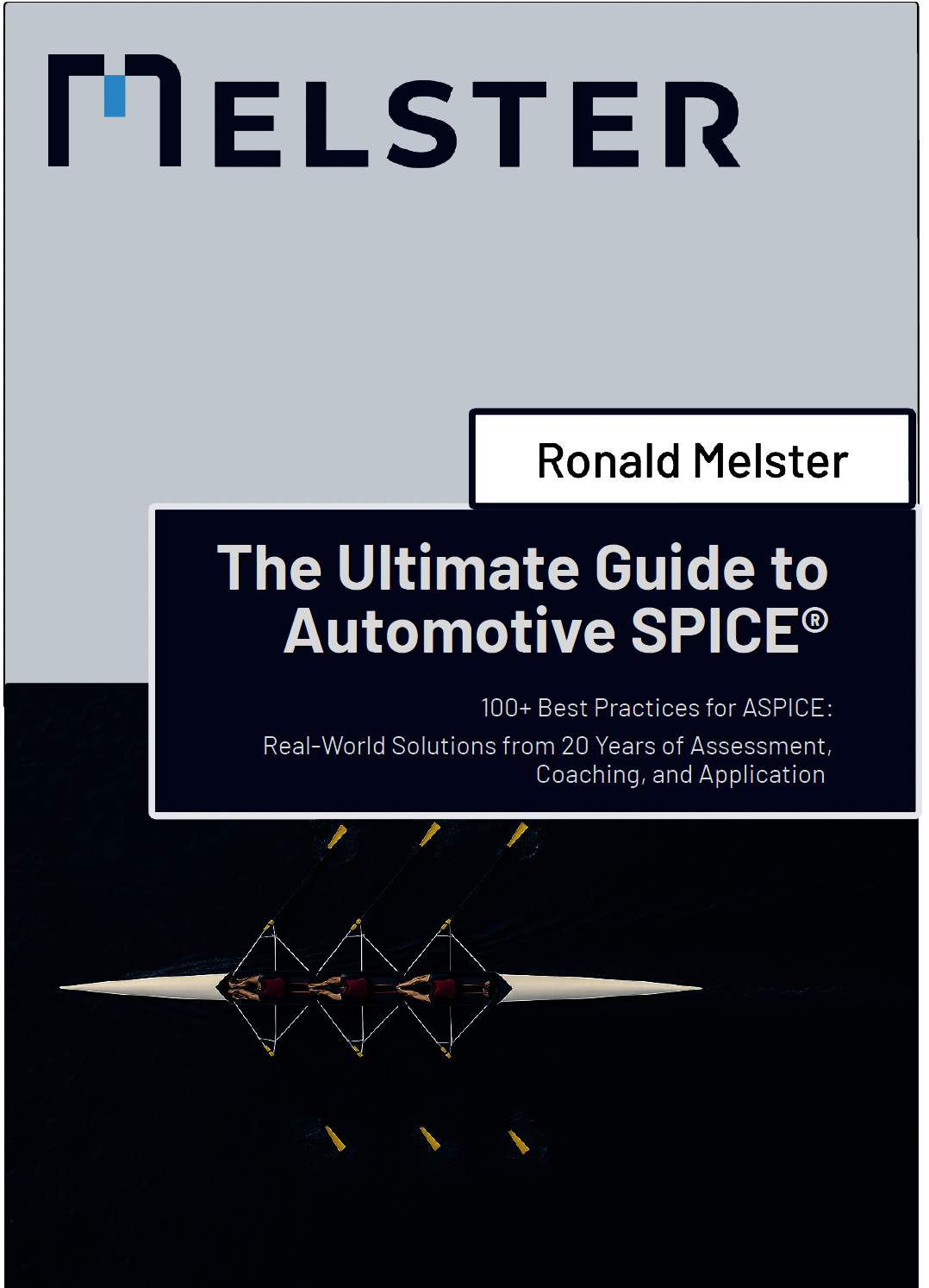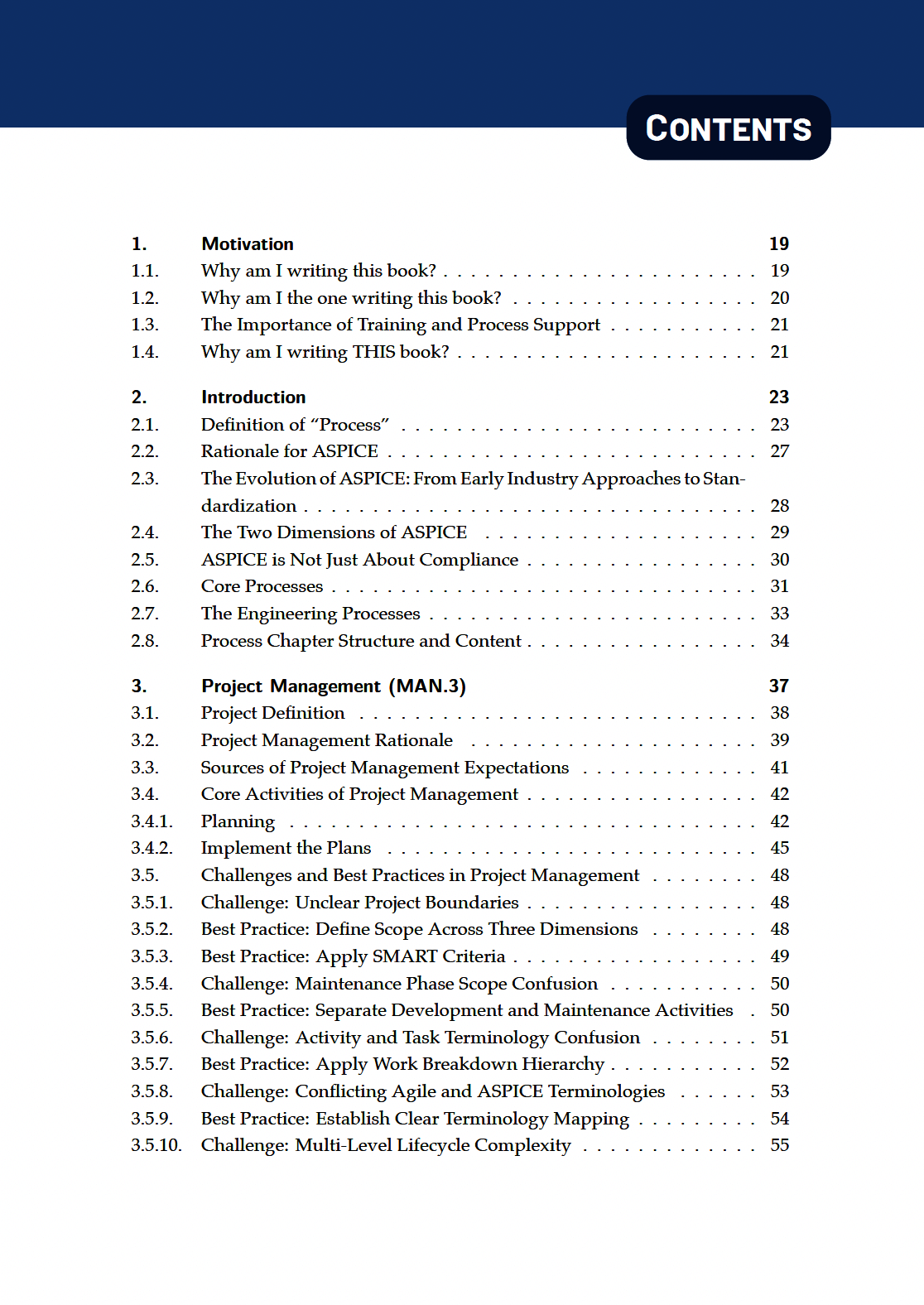The Ultimate Guide to Automotive SPICE® Assessments
The Human Side: Challenges and Best Practices for Teams and Assessors
Die praktische ASPICE-Bibel für Qualitätsprofis & Projektteams
„The Ultimate Guide to Automotive SPICE®“ bietet praxisnahe, direkt anwendbare Lösungen für typische Herausforderungen bei der Umsetzung von ASPICE in Engineering-Projekten.
Das Buch basiert auf jahrzehntelanger Assessment- und Coaching-Erfahrung und richtet sich an Teams, die ASPICE nicht einfach nur „bestehen“, sondern in messbare Prozessverbesserung und Projekterfolg übersetzen möchten.
Was macht dieses Buch besonders?
- 100+ Best Practices: Kompakte Handlungsanleitungen, die direkt aus realen Verbesserungs- und Assessment-Projekten stammen.
- Fokus auf Herausforderungen: Für jedes Praxisproblem wird eine erprobte Lösungsstrategie vorgestellt.
- Anschauliche Stories: Die theoretischen Forderungen des Standards werden mit Beispielen, Ansätzen und kurzen Geschichten aus dem Projektalltag verbunden – keine bloße Standardwiedergabe!
- Englische Ausführung: Das einzige aktuelle ASPICE-Buch auf Englisch – ideal für internationale Teams.
- Modern & kompakt: Keine trockene Prozessaufzählung mit Basispraktiken, sondern ein konsolidierter, strukturierter Leitfaden.
- Vom langjährig erfahrenen Assessor: Ronald Melster (BOSCH, Porsche, Audi, u.v.m.) verbindet 20 Jahre gelebte Prozessverbesserung in der Automobilbranche.
Buchdetails
- Autor: Ronald Melster
- Print-Ausgabe: 493 (A5-Format)
- eBook/Kindle: 222 (je nach Gerät)
- ISBN: 978-3-9827736-1-2 (Print)
- Erscheinungsdatum: 2025
- Verlag: Melster Consulting GmbH
Olga Polishchuk
Scrum Master at Luxoft
This book is a practical and insightful guide for applying ASPICE in real-world projects. I found the best practices especially useful for SUP.8, where the example on backup responsibilities helped clarify a key issue in my organization. The book is easy to follow, filled with real-life scenarios, and supported by valuable resources like masterclasses and interview guides. A great companion for any software professional working with ASPICE.
Olena Lizina
Senior Project Manager / ASPICE Provisional Assessor at Luxoft DXC
This book is a real treasure for anyone implementing ASPICE. I only wish I had it sooner! When I was starting out - it would have saved me so much time and uncertainty. Even today, I keep coming back to it whenever I need to refresh my memory or gain clarity. What makes it truly special is that it's written for the people who build and improve processes, not just for assessors.
Wojciech Dziembala
Project Systems Lead / Product Owner / Automotive / SAFe Leadership / Customer Relations / Systems Engineer / Project Management / ASPICE at Aptiv
The Most Practical and Inspiring ASPICE Guide Available
This book is an absolute game-changer for anyone working with Automotive SPICE®. I've read other resources on ASPICE, but none of them manage to combine practical depth, expert authority, and clarity the way this one does. It really exceeded my expectations. What makes it stand out is how the author begins with the Core processes, which are mandatory for Level 2 and in practice the real foundation for starting and structuring any project. Too often these are treated as secondary, but here they are placed exactly where they belong - at the entry point to successful engineering.
I also really like the way processes are grouped and compared across domains. For example, showing SYS.2 alongside SWE.1 and HWE.1, or SYS.3 with SWE.2, HWE.2, and SWE.3, makes the V-model come alive not only for systems but also for software and hardware. This structured comparison helps to understand ASPICE as a coherent engineering model instead of isolated checklists.
On a personal note, if I had read this book earlier, before creating my own ASPICE Basics course, it would have made my work even better. I did use the Melster Academy as a source, but this book goes far beyond. It is a true collection of best practices (not just base practices), guiding the reader on how to build processes that make achieving Level 2 or higher much easier and more natural.
For me, this is the book I wish I had years ago. It combines clarity, structure, and practical insight in a way no other ASPICE resource does. Reading it feels like having an expert assessor sit beside you, guiding you through each step.
Katarzyna Czerwiec
Quality manager / IATF 16949 Auditor Ex-Aptiv
Ronald Melster’s The Ultimate Guide to Automotive SPICE® is a clear, practical, and experience-driven handbook for anyone working with ASPICE. Unlike many texts that focus on compliance, this book emphasizes real process improvement and engineering success. Drawing on decades of industry experience, the author explains not just what ASPICE requires, but why it matters and how to apply it effectively. Each chapter balances concepts with actionable best practices, making it useful for engineers, project managers, and quality professionals alike. What stands out is the author’s pragmatic approach: ASPICE is presented not as bureaucracy, but as a framework that helps teams work faster, with fewer mistakes, and greater predictability. In short, this is an excellent resource for organizations seeking both compliance and genuine improvement in their engineering practices. Highly recommended.
Verfügbare Formate
| Format | Preis | Region | Bestellen |
|---|---|---|---|
| Druck (Amazon) | ~EUR 69 | Weltweit | Auf Amazon bestellen |
| Druck (BoD.de, nur DACH, Launch-Gutschein) | EUR 45 mit Gutschein EUR 55 regulär | DACH | Mit Gutschein bestellen |
| Kindle eBook | ~EUR 40 (kann regional variieren) | Weltweit | Auf Amazon bestellen |
| PDF (mit Wasserzeichen, Community-Edition) | EUR 42 | Weltweit | Hier bestellen |
Wählen Sie das Format und den Bestellweg, der Ihren Bedürfnissen am besten entspricht.
Für wen ist dieses Buch?
Dieses Buch richtet sich an:
- Ingenieure und Entwickler
- Projektmanager
- Qualitätssicherungs-Profis
- Führungskräfte, die nachhaltige Ingenieurkultur aufbauen wollen
Was lernen Sie?
Das Buch vermittelt 100+ Best Practices für ASPICE aus 20 Jahren Assessment- und Coaching-Erfahrung. Es zeigt, wie ASPICE in realen Projekten angewendet wird.
- Praktische Anwendung der wichtigsten ASPICE-Prozesse
- Best Practices aus Assessment- und Coaching-Erfahrung
- Lösungen für wiederkehrende Herausforderungen
1. Motivation (Page 25)
- Why am I writing this book?
- Why am I writing it as me?
- The Importance of Training and Process Support
- Why am I writing THIS book?
2. Introduction (Page 31)
- Definition of Process
- Rationale for ASPICE
- The Development of ASPICE
- The Two Dimensions of ASPICE
- ASPICE is not just Compliance
- Core Processes
- The Engineering Processes
- Process Chapter Structure and Content
3. Project Management MAN.3 (Page 49)
- Project Definition
- Project Management Rationale
- Sources of Project Management Expectations
- Core Activities of Project Management
- Challenges and Best Practices in Project Management
4. Quality Assurance SUP.1 (Page 101)
- Definition of Quality
- Quality Assurance Rationale
- Sources of Quality Expectations
- Core Activities of Quality Assurance
- Challenges and Best Practices in Quality Assurance
5. Configuration Management SUP.8 (Page 139)
- Definitions
- Configuration Management Rationale
- Sources of Configuration Management Requirements
- Core Tasks in Configuration Management
- Challenges and Best Practices in Configuration Management
6. Problem Resolution Management SUP.9 (Page 165)
- Definitions
- Rationale for Problem Resolution Management
- Sources of Expectations for Problem Resolution Management
- Core Tasks in Problem Resolution Management
- Challenges and Best Practices in Problem Resolution Management
7. Change Request Management SUP.10 (Page 201)
- Definitions
- Rationale for Change Request Management
- Sources of Expectations for Change Request Management
- Core Tasks in Change Request Management
- Challenges and Best Practices in Change Request Management
8. Requirements Engineering (Page 251)
- Definition of Requirement
- Requirements Engineering Rationale
- Sources of Expectations for Requirements Engineering
- Core Tasks in Requirements Engineering
- Challenges and Best Practices in Requirements Management
9. Architecture and Design in ASPICE (Page 289)
- Definitions
- Architecture Necessity and Benefits
- Sources of Expectations for Architecture Processes
- Core Tasks
- Differences between Architectures
- Challenges and Best Practices in Architecture and Detailed Design
10. Implementation Strategies (Page 337)
- Definitions
- Implementation Rationale
- Sources of Expectations for Implementation
- Core Tasks
- Challenges and Best Practices in Implementation
11. Integration Strategies (Page 357)
- Definitions
- Integration Rationale
- Sources of Expectations for Integration Processes
- Integration Verification across Software and System
- Core Tasks
- Challenges and Best Practices in Integration
12. Verification (Page 417)
- Definitions
- Verification Rationale
- Sources of Expectations for Verification Processes
- Core Tasks
- Challenges and Best Practices in Verification
13. Conclusion (Page 457)
- Key Takeaways from this Book
- Next Steps - How to Apply ASPICE in Practice
- Assessment Preparation Tools
- Personal Consultation
14. About the Author (Page 463)
A. List of Best Practices (Page 467)
B. Important ASPICE Concepts (Page 473)

